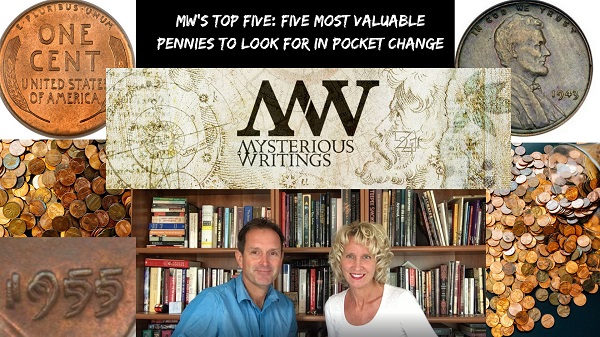Pennies are one of the most collected coins in pocket change. Thousands sit in drawers, jars, ash trays, cans, etc. Sometimes for decades. Many of them return to circulation and so it isn’t unheard of that one of the pennies on the list below might make it into your pocket.
Take a moment to look for them! You could find a penny worth thousands!
Watch on Video or read below:
1)The 1955 Double Die Cent
One of the less rare error cents for collectors to look for is the 1955 Double Die Cent. The US Mint produced and released about 24,000 one cents which have a double image. This Doubling is seen most in the date, and was caused by a misalignment of the second strike. Check your change for these as they often sell for over $1000 dollars.
2)A 1943 Copper or a 1944 Steel Penny
The World War II demand for copper resulted in the US to mint Steel Pennies in 1943, instead of the normal copper. Steel plates used to make pennies replaced the copper. However, a few coins were minted in 1943 which were copper, and not the intended steel. These coins are extremely valuable and collected today.
The Steel Penny of 1943 had its issues, and so the US Mint returned to making Copper Pennies in 1944. However, just like what happened in 1943 when the Mint switched to Steel, wrong plates were used for a few coins. This resulted in Steel Pennies, and not Copper Pennies to be minted and go into circulation in 1944. These are error coins and again are highly collected and valuable.
3)The Wheat Penny
Many people collect Wheat Pennies. These are one cent coins produced from 1909 to 1958. The coins are easily recognizable as they feature two wheat heads on the reverse and President Lincoln on the obverse. Although most wheat pennies are more valuable than one cent (maybe 10 cents), there are a few key years to look for which are worth considerably more than the face value of one cent. One example is the 1909 VDB – S (#5 on this list)
Other years to look for are: 1914, 1915, 1922 (more in #4), 1924, 1926, 1931, 1943 (more in #2), 1944 (more in #2), and 1955 (more in #1). There are various reasons why some are worth more, but mainly because of rarity.
4) The 1922 Plain Cent
The 1922 wheat penny without a Mint Mark, is not a coin minted in Philadelphia (which often doesn’t show the P mint mark), but is actually an Error Coin from the Denver Mint. The mintmark on the Die that Denver used to strike the design on the coin filled with dirt creating coins without mintmarks or mintmarks which are very faint. This coin is highly collected, and a slot for it is often found in Coin Collector albums. But why? It’s not an official minted coin, but an error coin.
It is believed the reason for this is because the Philadelphia Mint didn’t produce any Lincoln Cents in 1922, but had in all the years before and after, so to fill this gap, they include the 1922 Plain Cent which looks like how the cent would have appeared if the Philadelphia Mint had produced them.
But these 1922 plain cents are rare and are often worth thousands of dollars as many collectors need them to complete albums.
5) The 1909 VDB Cent
In 1909, the Lincoln One Cent replaced the Indian Head One Cent which had been in production since 1859. The designer’s initials for this new coin, V.D.B. for Victor David Brenner, were included in the earliest productions of the coin. The public, however, felt the initials VDB were too prominent and so the US Mint decided to remove the initials, but only after some coins were released.
These early coins which include the initials VDB below the Wheat Stalks on the reverse of the coin, and of which include the S mint mark, are highly collected because of their rarity. They are considered the most valuable of Wheat Pennies and can value thousands of dollars (depending on condition).
1909 VDB coins minted from Philadelphia are not as valuable. They may fetch only a few dollars. The reason for this is because the Philadelphia Mint produced and released millions of 1909 VDB cents from their Mint before the change. The San Francisco Mint had only released 484,000.
It should be noted the initials, VDB, were designed to be smaller and placed on Lincoln’s shoulder on the obverse, and restored to the One Cent in 1918.
.

